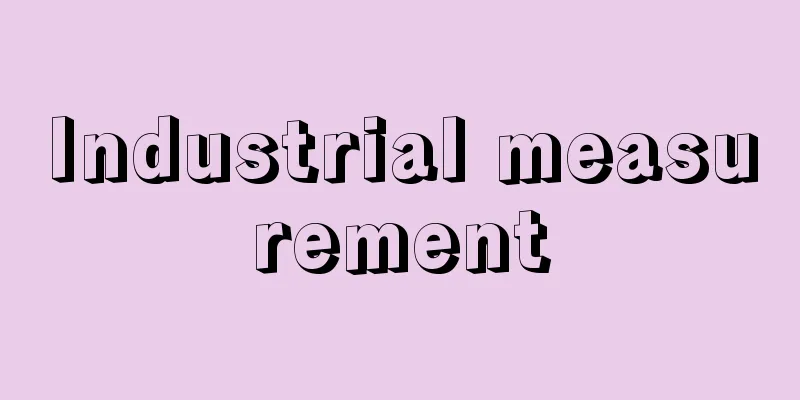Industrial measurement

|
The applications of measurement technology can be broadly divided into academic scientific research and the improvement of industrial efficiency related to the production of goods and energy. Of the latter, the measurement of industrial quantities carried out during or related to the industrial production process is called industrial measurement. Here, industrial quantities include not only condition quantities such as temperature, pressure, and flow rate, but also the state and quality of products. Measurement technology plays an important role in automating production with the aim of high production efficiency and labor saving. The equipment and systems used in industrial measurement are industrial instruments or industrial measurement systems. The latter has built-in automatic control functions. [Hiroo Yamazaki] The role of industrial measurement and automationIt was recognized that the conventional methods that relied on human skill were no longer sufficient for companies to generate profits by mass-producing homogeneous products quickly, and so measured operation, in which operating conditions are accurately grasped through measurement, became widespread. In Japan, this was after World War II, later than in Europe and the United States. This further developed into an automated process that automatically controls operating conditions. In automated industrial production, it is most important to check the quality of each process from raw materials and materials to the final product, monitor the operating status, and feed back the state of the controlled object to maintain the desired state. Therefore, industrial measurement, which obtains feedback information, plays a central role in automation technology. In the field of automation, process automation, which targets continuous processes, was the first. This is because the means of collecting accurate information about the object were in place. Furthermore, in continuous processes, the raw materials, intermediates, and products are fluids (liquids or gases), so control operations can be easily performed continuously by opening and closing flow control valves. Following continuous processes such as oil refining, automation of batch processes, which perform chemical reactions in batches (a method in which raw materials are not continuous but are reacted intermittently in batches depending on the capacity of the equipment), followed. As a result, the oil refining process, in which gasoline, diesel, etc. are separated from crude oil by continuous distillation, led the way in automation. Next, the chemical industry, which performs processes such as cracking, polymerization, and filtration in batches, was automated using process automation technology. In contrast, mechanical automation, which aims to automate the automobile and electronics industries, lagged behind because the production objects are solids and discontinuous processes, and the objects to be measured are not temperature or pressure like fluids, but rather the object's position and dimensions, or more broadly speaking, its tangible state, and there were no tools in place to collect feedback information necessary for automatic control. However, this situation changed with the development of sensor technology, which allowed robots to obtain information equivalent to vision and touch. At the same time, intelligent robots that could flexibly respond to the object's state and perform delicate operations were realized, and automated assembly processes emerged. As a result, mechanical automation became more advanced in the automobile and semiconductor industries, leading to the development of comprehensive factory automation (FA). Industrial measurement technology also contributes greatly to facility maintenance, disaster prevention, environmental conservation, etc. For example, measurement and control devices can detect abnormal situations and send out warnings, and take over human work under dangerous or harsh conditions. [Hiroo Yamazaki] Development of industrial measurement technologyAfter World War I, there was a growing momentum in Europe and the United States to systematically apply measurement technology to industrial production. First, signal conversion technology was pursued to convert the target industrial quantity into an easy-to-handle quantity, and various industrial instruments were developed to display or record the output of the converter. These had a robust structure that could be used at production sites. In process industries, flow control valves operated by air pressure or hydraulic pressure were widely used, so controllers with regulators built into industrial instruments to control the valves became widespread. Such process controllers were developed one after another by American manufacturers such as Honeywell, Foxboro, and Taylor in the 1930s, paving the way for process automation. In this period, the purpose of most automated processes was to maintain constant values such as pressure, temperature, and flow rate through feedback control. Controllers have a proportional-integral-derivative action (PID three-term action) function as their adjustment function, and are built into industrial instruments that display target values and measured values, and are called controllers because the measurement and control functions are integrated within the instrument. Controllers are installed on site for each control loop. The air pressure signals that operated the valves had a standardized level of 0.2 to 1 kg/ cm2 . In this way, leading up to World War II, not only did the measurement operations of plants in the United States and Germany advance, but automation began with constant value control. [Hiroo Yamazaki] The birth of process instrumentation systemsIn the 1950s, against the backdrop of advances in automatic control technology, a new idea for constructing measurement and control systems was born. This was to configure the system with standard devices corresponding to a series of functional elements such as detection, conversion, transmission, signal processing, control, and output, and to adopt the aforementioned unified level of air pressure signal of 0.2 to 1 kg/ cm2 for variables after detection. The variable range was made to correspond to a unified air pressure signal, and in particular the reason why the variable 0 was made to correspond to the lowest finite value of 0.2 kg/ cm2 air pressure was to identify cases where the air pressure was 0 in the event of a malfunction. This method was welcomed by both users and manufacturers as it brought about rationalization in system configuration and standardization of measurement systems. Meanwhile, in Japan in the early 1950s, full-scale measurement operations were virtually nonexistent except at some oil refineries that had introduced American equipment. There was no thought of using instruments with delicate structures in harsh production environments. However, when production was being restored after the Second World War, American experts pointed out the lack of measurement in production plants and the inadequacy of quantitative operation guidelines. In addition, in order to make effective use of fuel, which was often in short supply, the importance of heat management in the production process was emphasized, and the need for measurement operations was strongly recognized in the steel and chemical industries, which consume large amounts of fuel. Furthermore, measurement management that realizes heat management based on that technology spread rapidly. Measuring instrument manufacturers recognized the technological gap between Japan and the United States brought about by the interruption of technical exchanges due to the war, and began to actively promote full-scale technology introduction and domestic production. At that time in the United States, highly sensitive automatic balancing recorders (servo-type instruments) that could be used in harsh environments had been put to practical use, and regulators with pneumatic regulators were widespread. In Japan, measurement instrument manufacturers also focused on the development of industrial instruments, starting with the mass production of auto-balancing recorders with electronic tube amplifiers. Then, auto-balancing controllers combined with pneumatic regulators were introduced to processes in the mid-1950s, and process instrumentation began. As the scale of production grew, the number of measuring points in process instrumentation increased rapidly. To improve management efficiency, industrial instruments were no longer distributed around the production site, but were instead centralized in an instrument room. In the centralized management system, the display, recording, and adjustment units of industrial instruments were centrally installed on an instrument panel in a central control room. In this case, many large recorders were installed on the panel, and it became difficult to understand which variable in the process the indication was for, so graphic panels were introduced. The graphic panel, which is considered a symbol of the centralized management system, illustrates the production flow and the layout of equipment on a panel in the instrument room, and displays the flows of materials and energy connecting each production process and the flow of measurement and control signals with symbols and colored lines. In addition, instruments were placed at the measuring points on the flow diagram, making it possible to see the entire operation at a glance. In parallel with the introduction of graphic panels, there was a demand to miniaturize the instruments installed on the panel. Nevertheless, as the equipment became larger and the number of instruments increased, the panel area increased, which became a problem in terms of human monitoring ability and investment amount. In the 1950s, automatic balancing instruments using electronic tubes were introduced to processes, but there were problems with the connection to the pneumatic unified signaling system, which was the mainstream at the time. In addition, delays in the transmission of pneumatic signals became evident as the scale of processes increased. As a result, an electric unified signaling system was proposed. The electric unified signaling system had the advantage of having no response delay compared to the pneumatic system, and various control operations could be realized with analog electronic circuits, but it was slow to gain popularity due to the lack of reliability and economic difficulties of the electron tubes. However, the development of silicon transistors, which are sensitive to heat, overcame the difficulties of electron tubes, and in the early 1960s, the positions of electronic and pneumatic systems were reversed. In parallel with the practical application of these small electronic industrial instruments, electronic conversion of industrial quantities into unified level electric signals became possible, and electronic analog instrumentation technology was established. DC 4 to 20 milliamperes was used as the unified electric signal. In addition, when large power was required for operation, an operating converter (electro-pneumatic or electro-hydraulic) was used. [Hiroo Yamazaki] Introducing digital technologyUp until this time, process instrumentation systems formed independent feedback loops for each measurement control variable, and were controlled by analog controllers, so the interrelationships between multiple variables were unclear. Eventually, with the rapid development of digital electronics technology, changes also began to appear in instrumentation methods. First, data loggers appeared. Scanning monitors, instead of monitoring multiple instruments individually, switched multiple inputs in sequence in a set procedure, converted them into digital signals using an A/D converter, and displayed them numerically in a single display window or printed them out, and issued an alarm if the value deviated from the set value. This avoided an increase in panel area and made monitoring easier. Soon, with the improvement of data processing capabilities, this evolved into data loggers with automatic reporting functions such as daily operation reports that printed out the values of multiple variables at regular intervals, or monthly reports that compiled data for one month, in addition to the multi-point measurement and alarms mentioned above, and became widespread as a new centralized monitoring system. With this introduction, the interrelationships between process variables became clearer than before. Thus, the 1960s are considered to be the era when analog instrumentation was established and digital instrumentation technology began. The data logger's calculation function improved and it evolved into a computing logger that could average and integrate data, laying the foundation for computer control. However, it is important to note that the centralized processing power of the logger and computer is parallel to the feedback control function and does not directly handle control signals, i.e., it is outside the feedback control loop, so even if the computer breaks down, the control will not be affected. That is how important it was to consider reliability in the continuous operation process. Digital computers became smaller and more reliable as they began to use integrated circuits (ICs). Furthermore, control computers were developed with reliability as the top priority, and the digitalization of instrumentation was promoted by using measurement and control systems centered on them. In the early days, a control method was used in which a computer gave the setting value to a group of analog controllers, and this was called SPC (set point control). Eventually, DDC (direct digital control) was used, in which the output of the control computer directly controls the target. Even in the case of DDC, measures were taken to consider reliability, such as a duplicated computer configuration and installing analog controllers as backups in important control loops. DDC not only reduced the number of analog controllers and made them smaller by centralizing processing on a computer, but also made the instrument room more compact. When microprocessors were developed in the 1970s, distributed DDC was developed, in which a small number of control loops were centralized on a microprocessor and the risk of failure was distributed across multiple microprocessors. This configuration has been used to this day. The introduction of distributed DDC has brought about a major change in the interface with operators who operate and monitor industrial instruments and control systems. That is, the introduction of cathode ray tube displays (CRT displays) and keyboards. Until then, operators had to monitor the display of each analog instrument and operate each instrument individually, but this has changed to a centralized display on a CRT and centralized operation using a keyboard. The CRT display allows the operator to freely select what is displayed, from the entire process to individual instruments, and has solved the problems that arose with the graphic panel mentioned above. However, since the display must be called up using the keyboard, there was a problem with how to respond in an emergency, and since it is a virtual image, there was also a problem with ensuring transparency between the actual object and the image. Another advantage of the introduction of DDC is that it has become easier to clarify the relationships between multiple process variables and control loops, making it easier to operate the entire process while grasping the overall situation. [Hiroo Yamazaki] Sensors and transmitters for process measurementWhat kind of detectors or sensors are used at the forefront of industrial process measurement systems? When a process is operating stably, the balance of materials and energy entering and leaving the process must be zero. In other words, materials and energy enter and leave the process in various forms, such as raw materials, fuels, products, and waste gases. To monitor and control these flows, various sensors are used. These include sensors for temperature, flow rate, pressure, density, liquid level, velocity, and composition. Of these, since materials and energy take the form of fluids such as liquids and gases, flow sensors are closely related to the balance of both and are directly involved in control, making them the most important and most widely used. Flow sensors must have a sturdy structure because they come into contact with the flow. The most commonly used flowmeter is a flowmeter that inserts a flowmeter into a pipe and detects the pressure difference (pressure difference) between before and after the flowmeter. Other flowmeters that use electromagnetic flowmeters that use the Lorentz force acting on charges that cross a magnetic field, and vortex flowmeters that count the number of Karman vortices emitted from a cylindrical object in the flow, are used depending on the target and flow conditions. When the mass flow rate through a pipe is required from the viewpoint of material balance rather than the volumetric flow rate, a mass flowmeter using the Coriolis force is used. After the flow sensor, many temperature and pressure sensors are used. These sensors not only detect signals, but also function as converters (or transmitters) that convert the sensor output into a standardized level signal and transmit it. When a standardized level signal of air pressure was used, the flow rate, pressure, liquid level, etc. were all converted into differential pressure, which was then converted into a standardized level of air pressure and transmitted. Temperature was also converted into air pressure using the thermal expansion phenomenon. After the instrumentation changed to electronic system, the signal was converted into a standardized level of 4 to 20 milliamperes of direct current by a converter installed near the sensor and transmitted. The 4 milliampere portion of the transmitted signal supplies power to the converter, which is also used to check the zero level and the normal operation of the converter. The converter is connected to the display instrument or computer with only two conductors, which simultaneously transmits the information from the sensor signal and the operating energy of the converter. When sensors and transducers are used in an atmosphere where there is a possibility of explosion or ignition, they must be explosion proof. This includes not only pressure-resistant explosion-proof types that simply house circuits in pressure-resistant containers, but also intrinsically safe types that are designed with circuits that ensure that spark energy caused by faults such as broken wires or grounding is below the level that would explode hazardous gases. The advent of microprocessors has also had an impact on sensor converters. Since the 1980s, microprocessors have been built into converter circuits, enabling signal processing that was not possible with conventional analog circuits. In other words, they perform precise compensation for sensor characteristics, changes in measurement range, removal of specific noise, and monitoring of the operation of the conversion circuit. Communication with the instrument is performed using digital signals superimposed on analog current signals. Analog circuits had limited signal processing functions, but the incorporation of microprocessors and memory has allowed intelligence to be embedded in devices installed in the field. These are called smart or intelligent converters. Since reliability is very important in industrial measurement, safety-first considerations are added, such as fail-safes against failures of sensors and circuit elements installed in harsh operating environments, and embedded intelligence is also utilized here ( ). [Hiroo Yamazaki] Modern Industrial Measurement SystemsCurrent process measurement and control systems not only maintain constant quantities of production conditions, but also have the function of optimizing various conditions to maximize profits. Since profits are closely related to business strategies, raw material costs, production volume, etc., a hierarchical system is formed in which the measurement and control system is connected online or offline to the management information system and production management system related to factory production plans. In such cases, a hierarchical system is constructed, with the company's management information system at the top, the factory's production management system connected below that, and the process measurement and control system connected below that. Information is exchanged between the layers, and the system functions organically as a whole, but the instrumentation system is given optimized control target values by the higher-level system. Although the instrumentation system, which directly measures and controls processes that handle large amounts of energy and materials, is at the bottom of the hierarchy, it is required to have the highest reliability. Since the 1990s, attempts have begun to utilize personal computers (PCs), whose performance and reliability have improved, for industrial measurement and control. So far, there have been many cases where PCs have been used as man-machine interfaces instead of CRTs, but there are few cases in which their information processing capabilities have been used for online measurement and control in the process. However, there are still concerns about the reliability of PCs. A notable technological trend seen in the early 21st century is the change in the connection between sensors/transducers and computers. Until now, the central equipment in the instrument room and the sensors/transducers at the measurement site, or the central office and the control valve, which is the control operation terminal, were each connected one-to-one with their own conductors. Even though information processing was digital, the signal transmission was mostly analog current signals. Therefore, when the process became large-scale, the wiring cost increased and the central office was troubled by a large number of bundles of conductors. This is changing to a connection using a field bus that transmits digital signals. The bus transmits signals by sharing one or two bus wirings laid in the process. This not only reduces wiring costs, but also increases the capacity of signal transmission and increases the flexibility of connections. Another technological trend is the use of wireless transmission instead of fixed lines. This not only significantly reduces wiring costs, but also makes it easier to measure moving objects and control large areas. However, issues such as interference and security remain. [Hiroo Yamazaki] Measurement in Mechanical AutomationMechanical automation began with playback robots that performed simple repetitive tasks, such as welding and painting processes in automobile factories. In these, sensors were used to determine whether the workpiece to be processed (in this case, the body or parts of the automobile being processed) was in the correct position, and the number and variety of measurement sensors was not large at first. When mixed production began, where multiple car models were produced on one production line, it became necessary to identify the car model and specifications, and the processing program was changed accordingly. As the bonding process in semiconductor integrated circuit (IC) manufacturing and the installation of parts on circuit boards in electronic device manufacturing were automated using dedicated robots, video camera images were used to identify objects and correct their positions. In these cases, image processing technology was used to match with normal images. Thus, most mechanical automation measurement sensors do not measure specific variables and express them as numerical values, but rather recognize whether an object exists or not, and whether the object is correct or not. Therefore, the results were not numerical, but binary, such as normal or not. Here, the accuracy of the video camera image becomes an issue, but in addition, appropriate lighting and high-speed image processing for judgment are technically important. In order for robots and other automated machines to be able to perform more advanced and delicate tasks and to be able to flexibly respond to changes in the situation, they need sensors similar to those used by humans, but currently, visual and tactile sensors are the norm. Some sensors emit ultrasonic waves and detect the presence of objects or obstacles by their reflection, but these should be seen as a complement to visual and tactile senses rather than hearing. As intelligent robots become more sophisticated, they are increasingly using angle and force sensors to measure not only the rotation angles of arms and shoulders, but also the grip strength of fingers. These sensors inside robots are called internal sensors, and are distinguished from external sensors that obtain information from the outside. Thanks to measurements made by these internal sensors, robots are becoming more accurate and capable of carrying out delicate tasks. [Hiroo Yamazaki] Environmental conservation measurementWhether it is a process or assembly industry, production sites emit waste gases and wastewater during production. However, this cannot be allowed to degrade the environment. For this reason, environmental regulations have been established, and emissions cannot exceed the regulated values. Therefore, gases emitted into the atmosphere and wastewater discharged into rivers are constantly monitored using analyzers and measurement systems according to prescribed methods. [Hiroo Yamazaki] "Introduction to Industrial Measurement Systems" by Yasuo Nosaka (1987, Tokai University Press)" ▽ "Practical Industrial Measurement" by Yu Matsuyama (1999, Nikkan Kogyo Shimbun)" ▽ "Measurement Engineering Handbook" edited by Hiroo Yamazaki et al. (2001, Asakura Publishing) ▽ "Fundamentals of Industrial Measurement and Control - An Easy Guide to Instrumentation Written by a Manufacturer's Engineer" by Sadao Kawamura and Yojiro Ishikawa (2003, Kogyo Gijutsusha)" [Reference] | | | | | | | | | | | | | | | |(1) The pressure difference Δ between the pressure upstream of the orifice and the pressure at the orifice is proportional to the square of the flow rate (Δ∝). It can be used for both gases and liquids. (2) If the number of vortices released downstream from a cylindrical object is counted per second, it is proportional to the flow rate (m/sec) (∝). It can be used for both gases and liquids. (3) When a conductive liquid is subjected to a magnetic field , Representative examples of process measurement sensors (flow rate sensors) Source: Shogakukan Encyclopedia Nipponica About Encyclopedia Nipponica Information | Legend |
|
計測技術が応用される目的は、学術的な科学研究と物やエネルギーの生産にかかわる産業の効率化とに大別される。後者のうち、とくに工業の生産過程において、または生産に関係して行われる工業量の計測を工業計測という。ここで工業量とは温度、圧力、流量などの条件量だけでなく、製品の状態や品質などを含む。高い生産効率、省力化を指向して生産を自動化するために計測技術が重要な役割を果たしている。工業計測に用いられる機器やシステムは工業計器ないし工業計測システムである。後者においては自動制御の機能を内蔵している。 [山﨑弘郎] 工業計測の役割とオートメーション均質な製品を大量かつ迅速に生産して企業が利潤を生み出すためには、人間の熟練に依存するこれまでの方法では対応しきれないことが認識され、運転の条件量を計測により正確に把握して操業する計測運転が普及した。日本では欧米に遅れて第二次世界大戦後であった。これがさらに、運転条件を自動制御するオートメーション工程に発展した。 自動化された工業生産において、原料や素材から最終製品に至る全工程を通じ、それぞれ品質を確認したり、操業状態を監観して制御対象の状態をフィードバックして対象を希望した状態に保つことがもっとも重要である。したがって、フィードバック情報を獲得する工業計測が自動化技術の中核的役割を担っている。オートメーションの分野では、連続プロセスを対象とするプロセス・オートメーションが先行した。対象に関する適確な情報を収集する手段が整備されていたためである。さらに連続プロセスでは、素材や中間体、そして製品が流体(液体または気体)であるために制御の操作が流量調節バルブの開閉調節で容易に、しかも連続的に行われるからでもあった。石油精製などの連続プロセスについで、化学反応をバッチ(連続でなく装置の容量に応じてバッチという単位で原料をくぎって断続的に反応させる方式)で行うバッチ・プロセスの自動化が続いた。その結果、原油からガソリンや軽油などが連続蒸留で分離される石油精製プロセスが自動化の先頭をきった。それに次いで分解、重合、濾過(ろか)などの工程をバッチで行う化学工業がプロセス・オートメーション技術で自動化した。 これに対し、自動車や電子機器産業の自動化を図るメカニカル・オートメーションが立ち遅れたのは、生産対象が固体で、不連続プロセスであるため、計測の対象が流体のように温度や圧力ではなく、対象の位置や寸法など、広くいえば形をもつ状態で、自動制御に必要なフィードバック情報を収集するツールが整備されなかったからであった。しかしこの状況も、センサー技術が発展してロボットが視覚、触覚などに相当する情報を入手できるように変わった。それとともに、対象の状態に応じてフレキシブル(柔軟)に対応でき、微妙な操作が可能な知能化ロボットが実現して、組立ての自動化工程が出現した。その結果、自動車産業や半導体産業などでメカニカル・オートメーションが高度化して、総合的なファクトリー・オートメーション(FA)の展開をみるに至ったのである。 工業計測技術は、施設の保守、防災、環境の保全などにも多大の貢献をしている。たとえば、異常状況を察知して警報を発信し、危険または過酷な条件下における人間の作業を計測制御機器が肩代りすることなどである。 [山﨑弘郎] 工業計測技術の発展第一次世界大戦後、ヨーロッパやアメリカでは計測技術を工業生産の場に組織的に適用する機運が高まった。まず対象の工業量を取り扱いやすい量に変える信号変換技術が追求され、変換器の出力を表示あるいは記録する各種の工業計器が生まれた。これらは生産現場で使用できる堅牢(けんろう)な構造であった。プロセス工業では、空気圧あるいは油圧で動作する流量調節弁が多く使われたので弁を制御する調節器を工業計器に内蔵した調節計が普及した。このようなプロセス調節計が、1930年代アメリカのハネウェル、フォックスボロ、テーラーなどのメーカーで相次いで開発され、プロセスの自動化の道を開いた。この時期、自動化されたほとんどのプロセスがフィードバック制御により圧力、温度、流量などを一定値に保つことを目的としていた。調節計は、その調節機能として比例積分微分動作(PID3項動作)の機能をもち、目標値と計測値とを表示する工業計器に内蔵されて、計測と制御の機能が計器のなかで一体化されていて調節計とよばれた。調節計は制御ループごとに現場に設置された。弁を操作する空気圧信号はレベルが統一されており、0.2~1kg/cm2であった。こうして第二次世界大戦にかけてアメリカやドイツなどでプラントの計測操業が進展をみただけでなく、定値制御で自動化が始まった。 [山﨑弘郎] プロセス計装システムの誕生1950年代になると、自動制御技術の発達を背景に新しい計測制御システムの構成思想が生まれた。検出、変喚、伝送、信号処理、制御、出力など一連の機能要素に対応してシステムを標準的なデバイスで構成し、しかも検出以降の変量に、前述の統一したレベルの空気圧信号0.2~1kg/cm2を採用することであった。変量の範囲を統一された空気圧信号に対応させるが、とくに、変量の0を空気圧の0.2kg/cm2である最低の有限値に対応させたのは、故障時の空気圧0の場合を識別するためである。この方式はシステム構成の合理性と計測システムの標準化とをもたらすことから、ユーザー、メーカーの双方に歓迎された。 一方、1950年代初めの日本では、アメリカの設備を導入した一部の石油精製工場以外に本格的な計測操業は皆無に等しかった。繊細な構造の計器を厳しい環境の生産現場で使用するような考えがなかったのである。しかし、第二次世界大戦後の生産復興にあたり、アメリカの専門家から生産プラントの計測の欠如と量的な操業指針の不備が指摘されていた。また、生産復興にあたって、不足がちであった燃料を有効に利用するため、生産工程における熱管理の重要性が叫ばれていたため、燃料を大量に消費する鉄鋼工業や化学工業をはじめとして計測運転の必要が強く認識された。また、その技術を基に熱管理を実現する計測管理が急速に普及した。計測器メーカーは戦争による技術交流の断絶がもたらした日米の技術格差を認識し、本格的な技術導入とその国産化を積極的に進めることとなった。当時、アメリカでは厳しい環境下で使用できる高感度の自動平衡型記録計(サーボ形計器)が実用化され、空気圧式調節器つき調節計が普及していたのである。日本においても計測器メーカーは電子管増幅器をもつ自動平衡型記録計の量産から工業計器の開発に注力した。そして、空気圧式の調節器と結合した自動平衡型調節計が50年代のなかばごろからプロセスに導入され、プロセス計装が開始された。 やがて生産規模の大型化に伴いプロセス計装は計測点数が急増したので、管理効率の向上を図るために、工業計器を生産現場に分散配置することを改め、計器室に集中して管理する方式となった。集中管理方式では、工業計器の表示・記録・調節部を中央管理室の計器パネルに集中して取り付けた。この場合、多数の大型記録計がパネルに配置され、その指示がプロセスのどの変数であるかわかりにくい問題が生じ、グラフィックパネルが導入された。集中管理方式の象徴とされるグラフィックパネルは、生産の流れと設備の配置を計器室のパネルに図示し、各生産プロセスをつなぐ物質やエネルギーの流れと計測制御の信号の流れをシンボルや色線で表示したうえ、流れ図の計測箇所に計器を配置して、全体の運転操業をひと目でわかるようにした。グラフィックパネル導入に平行してパネルに取り付ける計器の小型化が要請された。それでも、設備が大型化し、計器数が多くなると、パネル面積が増大し、人間の監視能力と投資額の点から問題となった。 1950年代から電子管を使用した自動平衡計器がプロセスに導入されたが、当時主流であった空気圧統一信号方式の計装との接点に問題があった。また、プロセス規模の増大により空気圧信号の伝送遅れが顕在化した。その結果、電気式統一信号方式が提案された。電気式統一信号方式は空気圧式に比し応答に遅れがなく、各種の制御動作がアナログ電子回路で実現できる利点は認められたが、電子管の信頼性不足と経済性が難点で伸び悩んでいた。ところが熱に弱いゲルマニウムトランジスタにかわって、シリコントランジスタの発達が電子管の難点を克服するにおよび、1960年代初めに至り電子式と空気圧の地位が逆転した。こうした小型電子式工業計器の実用化と平行して、統一レベルの電気信号への工業量の電子的変換が可能となり、電子式アナログ計装技術が確立されたのである。統一電気信号としては、直流の4~20ミリアンペアが用いられた。また操作に大きな動力を要するときは操作用変換器(電気‐空気圧、あるいは電気‐油圧)が使用された。 [山﨑弘郎] デジタル技術の導入プロセス計装システムは、この時代までは計測制御の変数ごとに独立したフィードバック・ループを形成し、アナログ調節計で制御されていたので、複数の変数の間の相互関係が不明確であった。やがて、デジタル電子技術の急激な発展を背景に計装方式にも変化が現れた。まずデータロガーの出現であった。スキャニングモニターは、多数の計器を個々に監視するかわりに、定められた手順で多数の入力を順次に切り換え、A/D変換器でデジタル信号に変換して一つの表示窓に数字表示、あるいは印字出力し、設定値からの逸脱を警報発信した。パネル面積の増大を回避し、かつ監視が容易になった。これはまもなく、データ処理能力の向上とともに、前記の多点計測、警報のほかに、多数の変量の値を一定時間ごとに印字する運転日報、あるいは1か月ごとのデータを集計した月報などの報告の自動作表機能をもつデータロガーに発展し、新しい集中監視システムとして普及した。この導入によりプロセス変量の相互関係が以前より明確になった。このように1960年代は、アナログ計装の確立ならびにデジタル計装技術の開幕の時代とされている。 データロガーは、演算機能を向上させ、データの平均や積算なども行うコンピューティングロガーへと進み、コンピュータ制御への礎(いしずえ)を築いた。ただここで注意しなければならないのは、ロガーやコンピュータの集中処理能力はフィードバック制御機能と並列で、制御信号を直接扱わない、すなわちフィードバック制御ループの外側であって、たとえコンピュータが故障しても制御には影響がない。そのくらい連続操業のプロセスにおいて信頼性に対する配慮が重要であった。デジタルコンピュータは集積回路(IC)を使用するようになって小型化するとともに信頼性が改善された。さらに制御用コンピュータは信頼性を最優先して開発されたコンピュータで、それを中枢とする計測制御システムにより計装のデジタル化が進められた。その初期にはコンピュータがアナログ調節計群の設定値を与える制御方式をとり、SPC(set point control)とよばれた。やがて制御用コンピュータの出力で直接に対象を制御するDDC(direct digital control)が行われるようになった。DDCの場合においても信頼性に対する配慮により、コンピュータの二重化構成や重要な制御ループにアナログ調節計をバックアップに設置するなどの措置がとられた。DDCはコンピュータの集中処理により多数のアナログ調節計を節減し、小型化しただけでなく、計器室をコンパクトにした。1970年代にマイクロプロセッサーが開発されると、少数制御ループをマイクロプロセッサーで集中処理し、複数のマイクロプロセッサーに故障時のリスクを分散した分散型DDCが開発された。この構成はそのまま現在に引き継がれている。 分散型DDCの導入において、工業計器や制御システムを運転、監視するオペレーターとのインターフェースが大きく変化した。すなわち、ブラウン管ディスプレー(CRTディスプレー)とキーボードの導入である。それまでは個々のアナログ計器の表示を監視し、操作も個々の計器に対して行っていたのが、CRTによる集中表示、キーボードによる集中操作に変化した。CRT表示ではプロセス全体から個別の計器の表示まで、自由に表示の対象を選択できるので、前述のグラフィックパネルで生じた問題は解消された。しかし、表示をキーボードで呼び出さなければならないので、緊急時における対応が問題であり、またバーチャル・イメージであるため実体との間の透明性の確保が課題であった。DDC導入のもう一つの利点は複数のプロセス変量や制御ループ相互の関連が明確化しやすくなり、プロセス全体の状況を把握しつつ総合的な運転がしやすくなったことである。 [山﨑弘郎] プロセス計測用センサーと変換器プロセス用工業計測システムの最先端に位置する検出器あるいはセンサーはどのようなものが使われているのだろうか。プロセスでは操業が安定しているときには、プロセスに出入りする物質とエネルギーの収支がゼロでなければならない。すなわち、原料、燃料、製品、廃ガスなどいろいろな形で物質とエネルギーとが出入りしている。それらの出入りを監視あるいは制御するため、いろいろなセンサーが使用される。温度、流量、圧力、密度、液位、速度、成分などのセンサーである。これらのなかで、物質やエネルギーが液体や気体など流体の形をとるので、流量センサーが両方の収支に密接に関係し、直接制御にもかかわるのでもっとも重要であり、使用数も多い。流量センサーは流れに接するのでじょうぶな構造でなければならない。管路に絞りを挿入して、その前後の差圧(圧力差)を検出する絞り流量計がもっとも多く使用され、磁場を横切る電荷に作用するローレンツ力を利用する電磁流量計、流れのなかの柱状物体から放出されるカルマン渦の数を計数する渦流量計などが対象や流れの状況に応じて使用される。物質収支の観点から体積流量より管内を通過する質量流量が必要な場合はコリオリの力を利用した質量流量計が使用される。流量センサーについで温度センサーや圧力センサーが多数使われる。これらのセンサーは信号を検出するだけでなく、統一されたレベルの信号にセンサーの出力を変換し伝送する変換器(あるいは伝送器)としての機能をあわせてもっている。空気圧の統一レベル信号が使用されたときには、流量、圧力、液位などすべて差圧に変換され、さらに統一レベルの空気圧に変換され伝送された。温度も熱膨張現象を利用して空気圧に変換された。計装が電子方式に変化してからはセンサーに近く設置された変換器で統一レベルの4~20ミリアンペアの直流電流に変換されて伝送される。伝送信号のうち、4ミリアンペアの部分は変換器の電源に電力を供給しており、それがまた、ゼロレベルと変換器の正常動作の確認に利用される。変換器と、表示計器やコンピュータとの間は2本の導線のみで接続され、それによりセンサー信号からの情報と変換器の動作エネルギーとが同時に送られるのである。 センサーや変換器類が爆発や、引火の可能性のある雰囲気で使用される場合には、防爆型explosion proofでなければならない。これには単に耐圧容器に回路を収容する耐圧防爆型のほかに、断線や接地などの故障で生じた火花エネルギーが危険ガスを爆発させるレベル以下となる回路設計を施した本質安全防爆型が採用される。 センサーの変換器にもマイクロプロセッサー出現の影響が現れた。1980年代から変換器の回路にマイクロプロセッサーが内蔵されて、従来のアナログ回路では実現できない信号処理が可能になった。すなわち、センサー特性の精密な補償や計測範囲の変更、特定のノイズの除去、変換回路の動作の監視などを実行する。計器との間はアナログ電流信号に重ねたデジタル信号で通信を行う。アナログ回路では信号処理機能が限定されていたが、マイクロプロセッサーやメモリーの内蔵によって現場に設置された機器にも知能が埋め込まれることになった。スマートあるいはインテリジェント変換器とよばれる。工業計測では信頼性が非常に重視されるので、厳しい動作環境に設置されるセンサーや回路素子の故障に対してもフェイルセーフなど、安全優先の配慮が加えられており、ここでも埋め込まれた知能が活用される()。 [山﨑弘郎] 現代の工業計測システム現在のプロセス計測制御システムでは、生産のための条件量を一定値に保持するだけでなく、利益を最大にするように諸条件を最適化する機能をもつ。利益は経営戦略や原料コスト、生産量などと密接に関係するので、経営情報システムや工場の生産計画などにかかわる生産管理システムなどと計測制御システムがオンラインあるいはオフラインで接続された階層システムを構成する。 このような場合、企業の経営情報システムが上位で、その下に工場の生産管理システムがつながり、さらにその下にプロセスの計測制御システムが接続されるような階層構造をもつシステムが構築される。階層間で情報が交換され、全体として有機的に機能するが、計装システムは、上位のシステムから最適化された制御の目標値を与えられる形となる。大きなエネルギーと大量な物質を扱うプロセスを直接計測制御する計装システムは階層としては下層であるが、もっとも高い信頼性が要求される。 1990年代から普及し、性能と信頼性が向上したパーソナルコンピュータ(PC)を工業計測や制御に活用する試みが始まった。いままでのところ、CRTのかわりにマン・マシン・インターフェースman-machine interfaceとして使われる例は多いが、情報処理能力をオンラインで計測制御に使用している例はプロセスでは少ない。そこには、まだPCの信頼性に対する懸念が残っている。 21世紀初頭においてみられる顕著な技術動向は、センサー・変換器とコンピュータとの接続形態の変化である。いままでは計器室内の中央の機器と計測現場のセンサー・変換器、あるいは中央と制御の操作端である調節弁との間はそれぞれ固有の導線で1対1で接続されていた。情報処理はデジタル信号でも信号の伝送はほとんどアナログの電流信号であった。したがって、プロセスが大規模となると、配線のコストが増大するし、中央では大量な導線の束に悩まされた。これがデジタル信号を伝達するフィールドバスで接続する方向に変わりつつある。バスはプロセスに敷設された1ないし2本のバス配線を共用して信号伝送が行われる。これにより配線コストが低減するだけでなく、信号伝送の容量が増加し、接続の融通性も増す。もう一つの技術動向は固定回線にかわる無線伝送の活用である。これにより配線のコストが大幅に低下するだけでなく、移動する対象の計測や広域の制御が容易になる。ただし、混信とかセキュリティの課題が残る。 [山﨑弘郎] メカニカル・オートメーションにおける計測メカニカル・オートメーションは単純繰返し作業を行うプレイバック・ロボットから始まった。自動車工場における溶接や塗装工程などであった。これは加工対象のワーク(ここでは加工される自動車の車体や部品など)が所定の位置にあるかどうかを判定するセンサーが使われる程度で、計測センサーの数や種類は当初多くはなかった。一つの生産ラインで複数の車種を生産する混流生産が始まると、車種や仕様の識別が必要になり、それに応じて加工のプログラムを切り替えた。半導体集積回路(IC)製造のボンデイング工程や電子機器製造における回路基板への部品装着などが専用のロボットを使用して自動化されるにしたがい、ビデオカメラ画像を利用して対象の判別や位置の修正を行うようになった。これらでは正常な画像とのマッチングを画像処理技術で行うものであった。 このように、メカニカル・オートメーションの計測センサーは特定の変量を計測し、数値で表現するのではなく、対象が存在するか否か、対象が正しいかどうかの正否を認識するものが大多数であった。したがって、結果は数値ではなく、正常か否かのように二値的であった。ここでは、ビデオカメラの画像の精度が問題になるが、さらに適切な照明や判定のための高速度の画像処理が技術的に重要である。 ロボットなどの自動機械がより高度で微妙な作業もこなし、しかも状況の変化に柔軟に対応できるようにするためには人と同様なセンサーが必要であるが、現在のところは、視覚、触覚センサーが主である。一部、超音波を発射して、その反射により対象や障害物の存在を知るセンサーが使われているが、聴覚というより視覚や触覚の補完とみるべきであろう。 知能化が進んだロボットでは、ロボットの外部の情報を取得するだけでなく、腕や肩などの回転角度や指の把持力などを角度センサーや力センサーで計測するものが増えてきた。このようなロボット内部のセンサーを内界センサーとよび、外部の情報を取得する外界センサーと区別する。このような内界センサーによる計測のおかげでロボットの作業が正確でしかも微妙な仕事をこなせるようになりつつある。 [山﨑弘郎] 環境保全計測生産の場はプロセスであれ、組立て産業であれ、生産のために廃ガスや排水などを放出する。しかし、それが環境を劣化することは許されない。そのために環境規制が定められており、その規制値を超える量を放出できない。したがって、大気に放出されるガスや、河川に放出される排水について定められた方法により常時分析計や計測システムによる監視が実施されている。 [山﨑弘郎] 『野坂康雄著『工業計測システム入門』(1987・東海大学出版会)』▽『松山裕著『実用 工業計測』(1999・日刊工業新聞社)』▽『山﨑弘郎他編著『計測工学ハンドブック』(2001・朝倉書店)』▽『川村貞夫・石川洋次郎著『工業計測と制御の基礎――メーカーの技術者が書いたやさしく計装がわかる』(2003・工業技術社)』 [参照項目] | | | | | | | | | | | | | | | |(1)絞りの上流の圧力と絞りにおける圧力との差圧Δが流量の2乗に比例する(Δ∝)。気体、液体の両方に使用可能(2)柱状の物体から下流に放出される渦の数を毎秒個とすると流量(m/秒)とは比例関係がある(∝)。気体と流体の両方に使用可能(3)電導性液体が磁界©Shogakukan"> プロセス計測用センサーの代表例(流量セ… 出典 小学館 日本大百科全書(ニッポニカ)日本大百科全書(ニッポニカ)について 情報 | 凡例 |
<<: Anticoagulant - anticoagulant
Recommend
Dordrecht
A city in the southwest of the Netherlands. 20 km ...
Kanji Restriction - Kanji Restriction
The aim is to improve the efficiency of learning a...
Fernán González
?-970 Founder of the Kingdom of Castile. Became th...
Edible frog (edible frog)
The common name for edible frogs. Frogs are eaten ...
Copy - Utsushi
1. To copy or replicate a work of art. 2. A docume...
jejunum
…The contents of the small intestine are transpor...
Hemorrhoids - Warts
〘 noun 〙 A type of hemorrhoids. Hemorrhoids that c...
Bomber - Bakugekiki (English spelling) bomber
A military aircraft loaded with bombs for bombing...
Dur Kurigalzu
A ruined city about 20km west of Baghdad, Iraq. It...
Exposure meter
An instrument that can calculate the combination ...
Amatsukume no Mikoto - Amatsukume no Mikoto
The legendary ancestor of the Kume clan who led th...
Gold cloth - Kanakin
It is said to be derived from the Portuguese word...
Sanshin
A lute-type plucked string instrument found in th...
ritual-clown
…This was probably a way for culture to prevent i...
Eishoki
This book records the regulations for taboos, defi...









